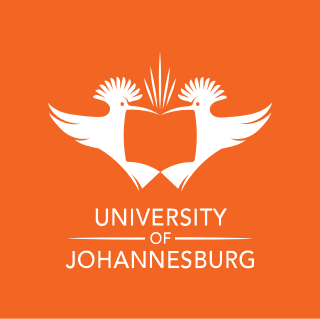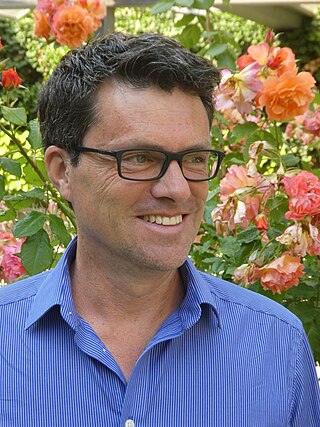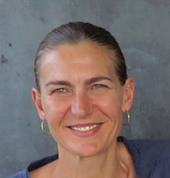Related Research Articles

Johannesburg, colloquially known as Jozi, Joburg, or "The City of Gold", is the largest city in South Africa, classified as a megacity, and is one of the 100 largest urban areas in the world. According to Demographia, the Johannesburg–Pretoria urban area is the 26th-largest in the world in terms of population, with 14,167,000 inhabitants. It is the provincial capital and largest city of Gauteng, which is the wealthiest province in South Africa. Johannesburg is the seat of the Constitutional Court, the highest court in South Africa. Most of the major South African companies and banks have their head offices in Johannesburg. The city is located in the mineral-rich Witwatersrand range of hills and is the centre of large-scale gold and diamond trade.

The University of the Witwatersrand, Johannesburg, is a multi-campus South African public research university situated in the northern areas of central Johannesburg. It is more commonly known as Wits University or Wits. The university has its roots in the mining industry, as do Johannesburg and the Witwatersrand in general. Founded in 1896 as the South African School of Mines in Kimberley, it is the third oldest South African university in continuous operation.

The Witwatersrand Gold Rush was a gold rush in 1886 that led to the establishment of Johannesburg, South Africa. It was a part of the Mineral Revolution.

The University of Johannesburg (UJ) is a public university located in Johannesburg, South Africa. The University of Johannesburg came into existence on 1 January 2005 as the result of a merger between the Rand Afrikaans University (RAU), the Technikon Witwatersrand (TWR) and the Soweto and East Rand campuses of Vista University. Prior to the merger, the Daveyton and Soweto campuses of the former Vista University had been incorporated into RAU. As a result of the merger of Rand Afrikaans University (RAU), it is common for alumni to refer to the university as RAU. The vice-chancellor and principal of UJ is Professor Tshilidzi Marwala who took office on 1 January 2018. Between 2005 and 2017, UJ's vice-chancellor and principal was Prof Ihron Lester Rensburg.

Sir Herbert Baker was an English architect remembered as the dominant force in South African architecture for two decades, and a major designer of some of New Delhi's most notable government structures. He was born and died at Owletts in Cobham, Kent.

The Palace of Sans-Souci, or Sans-Souci Palace, was the principal royal residence of Henry I, King of Haiti, better known as Henri Christophe. It is located in the town of Milot, approximately five kilometres (3 mi) northeast of the Citadelle Laferrière, and thirteen kilometres (8 mi) southwest of the Three Bays Protected Area. Being among the first buildings constructed in a free Haiti after the Haitian Revolution, the Palace and the neighboring Citadelle, are Haitian icons and global symbols of liberty, and were inscribed on the World Heritage List in 1982.

Joseph-Achille Mbembe, known as Achille Mbembe, is a Cameroonian historian, political theorist, and public intellectual who is a research professor in history and politics at the Wits Institute for Social and Economy Research at the University of the Witwatersrand. He is well known for his writings on colonialism and its consequences and is a leading figure in new wave French critical theory.
Patrick Bond is Distinguished Professor at the University of Johannesburg Department of Sociology. From 2020-21 he was professor at the University of the Western Cape School of Government and from 2015-19, distinguished professor of political economy at the University of the Witwatersrand Wits School of Governance. Before that, from 2004, he was senior professor at the University of KwaZulu-Natal, where he directed the Centre for Civil Society. His research interests include political economy, environment, social policy, and geopolitics.

Wilhelmus "Winy" Maas is a Dutch architect, landscape architect, professor and urbanist. In 1993 together with Jacob van Rijs and Nathalie de Vries he set up MVRDV.
Ruthann Robson is an American professor of law and University Distinguished Professor. As well as her writings in legal scholarship and theory, she has also published fiction, poetry, and creative nonfiction. Her novel Eye of a Hurricane was a finalist for the Lambda Literary Award for LGBT Debut Fiction.

Lesley Naa Norle Lokko is a Ghanaian-Scottish architect, academic, and novelist. From 2019 to 2020 she was a professor and served as Dean of Bernard and Anne Spitzer School of Architecture City College of New York, in addition to juggling teaching positions and different careers in Johannesburg, London, Accra and Edinburgh.

Gauvin Alexander Bailey is an American-Canadian author and art historian. He is Professor and Alfred and Isabel Bader Chair in Southern Baroque Art at Queen's University.
Ruth Sacks is a South African artist who lives and works in Johannesburg. She is currently a postdoctoral researcher in the South African Research Chair Initiative (SARChI) for Social Change at Fort Hare University. Sacks holds a PhD (Arts) from the University of the Witwatersrand where she was a fellow at the Wits Institute for Social and Economic Research (WiSER). Her third artist book, Twenty Thousand Leagues Under Seas, was launched in 2013. She is a laureate of the HISK in Ghent. She was one of the facilitators of the artist-run project space the Parking Gallery, hosted by the Visual Arts Network of South Africa (VANSA) in Johannesburg. Ruth Sacks' work has been presented internationally in venues such as the African Pavilion at the 52nd Venice Biennalein 2007, the ZKM Centre for Art and Media, Karlsruhe in 2011 and the National Museums of Kenya, Nairobi in 2017.

Lucinda Backwell is an archaeologist and a member of the Academy of Science of South Africa. She obtained her MSc in palaeoanthropology from the University of the Witwatersrand Medical School in 2000. Her PhD in palaeoanthropology was awarded in 2004, making her the first South African woman to be awarded a PhD in palaeoanthropology at a local institution.
The Great Synagogue on Wolmarans Street, Johannesburg, is known as the city's mother synagogue and "the crown jewel of Orthodox Judaism in South Africa." All large-scale Jewish events in the Gold City were held in the building, and for all its existence it was the seat of the country's chief rabbi. Northward migration by congregation members led to the synagogue relocating in 1994, to be replaced by the Great Park Synagogue on Glenhove Road, Oaklands, built on the model of the Great Synagogue, whose own architecture in turn was inspired by the Hagia Sophia.
Georgina Huljich is an Argentinean-American architect and educator. She is a partner in PATTERNS, a Los Angeles-based architecture firm. She has been teaching at the Department of Architecture and Urban Design at UCLA as an associate professor since 2006.
Bronwyn Law-Viljoen is a South African writer, editor, publisher and professor. She is the co-founder of the publisher Fourthwall Books and owns a bookstore called Edition. She acts as the primary editor for works on law and history of South Africa and the architecture and building process of its constitutional court structures, along with artistic book publications of the work of William Kentridge. She has also published her own novel called The Printmaker.

Marion Kathaleen Bamford is a Zimbabwean paleobotanist, and is a professor at University of the Witwatersrand in Johannesburg, South Africa.
Coleen Vogel is a South African climatologist involved in international work on climate change. She is a Distinguished Professor at the University of the Witwatersrand. In 2009 she was the third winner of the Burtoni Award for her work.
References
- 1 2 3 "Bremner, Lindsay | University of Westminster". www.westminster.ac.uk. Retrieved 2022-07-19.
- ↑ "Cyclone Shelter / Lindsay Bremner and Jeremy Voorhees". ArchDaily. 2012-01-27. Retrieved 2022-07-19.
- ↑ "Spatial Agency: Sans Souci cinema". www.spatialagency.net. Retrieved 2022-07-19.
- ↑ "Sans Souci Cinema". South African Informal City. Retrieved 2022-07-19.
- ↑ "in the terrain of water | Penn Design • LINDSAY BREMNER". terrain.design.upenn.edu. Retrieved 2022-07-19.
- 1 2 "Professor Lindsay Bremner, Principal Investigator | Monsoon Assemblages" . Retrieved 2022-07-19.
- ↑ "Writing the City into Being". Fourthwall Books. Retrieved 2022-07-19.
- ↑ "Lindsay Bremner". Actar Publishers.
- ↑ Bremner, Lindsay (2004). Johannesburg: One City, Colliding Worlds (in French). STE Pub. ISBN 978-1-919855-28-8.
- ↑ "About | Monsoon Assemblages" . Retrieved 2022-07-19.
- ↑ "Professor Lindsay Bremner awarded one-year planning grant for 'Sounding the Monsoon' project". www.westminster.ac.uk. Retrieved 2022-07-19.
- ↑ "British Architecture Professor Denied Entry Into India, Second Scholar to Be Deported in 2022". The Wire. Retrieved 2022-07-19.